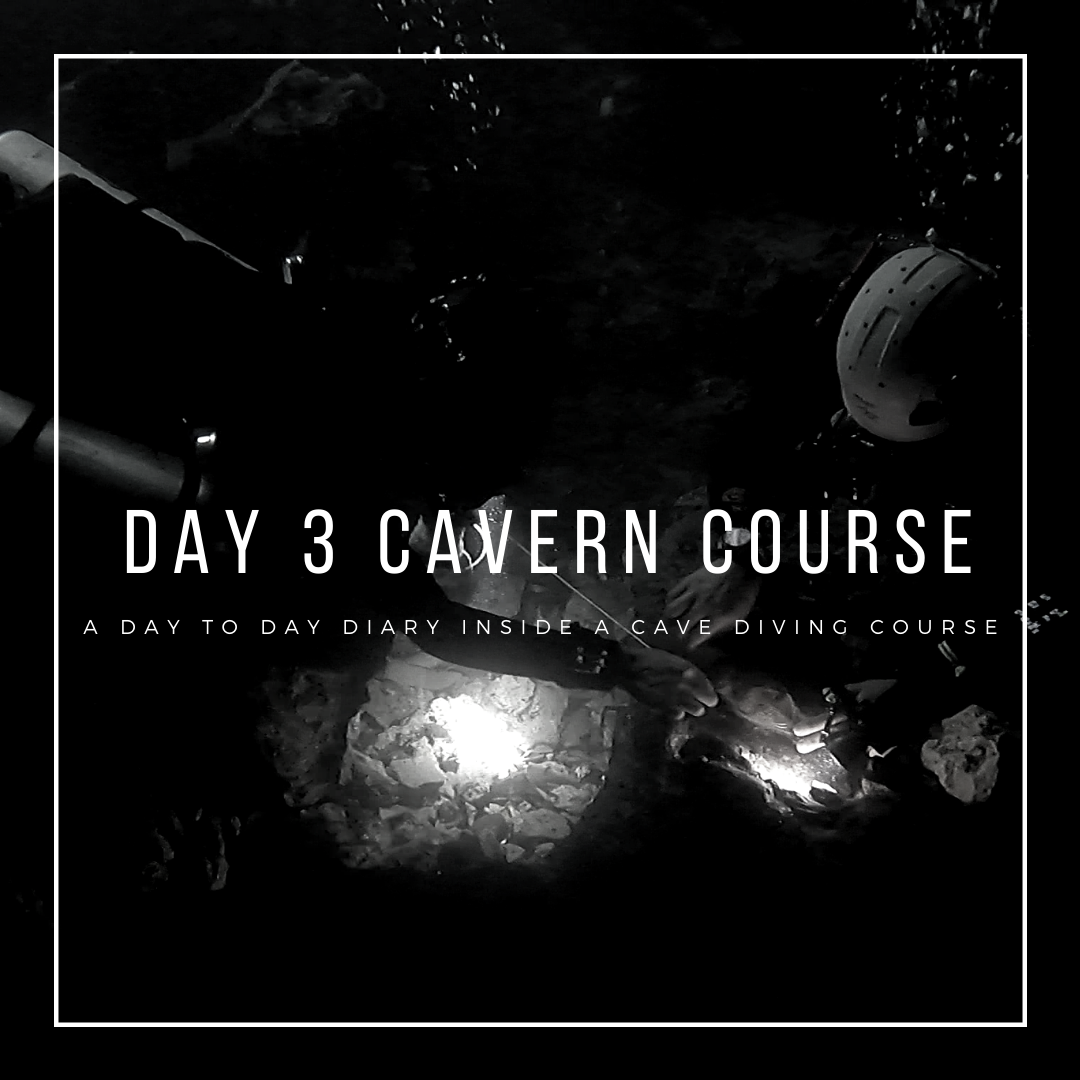Day 3 Cavern Diver Course
Location: Wangi-Wangi Island, Wakatobi.
Cave: Goa Teekosapi.
Dive time: 140 minutes
Cumulated Dive time: 429 minutes.
Today is a milestone day. A big day. A great day. The student may venture for the first time in the Overhead.
They will not see the light anymore.
The border between the cavern and the cave, between the light and the darkness, will be crossed.
Transitioning to this zone is no joke anymore. The reassuring light from the outside will be no more and this takes an actual toll on our mental.
That is why the third day starts with a vast, broad and interesting topic: stress management.
Cave Diving is a demanding activity in a very extreme environment, it does generate stress, whatever your dive experience or your life background. That’s why it is so important to know what we’re talking about and spend some time studying it:
- What is stress?
- What is our body response to it? Physically and mentally.
- How should we react to it?
- How to identify and eliminate stress sources?
- What are those sources?
- Physical
- Psychological
- How to recognize stress on yourself or your buddies?
- How to break the stress circle before it turns into Panic and eventually accident.
All those topics are critical and will help the students to prepare mentally to enter the cave and alleviate any doubt they could have at this point.
Once this is settled, a quick review on the auto evaluation and focus on more practical things.
Some more time is spend talking about the guideline. As the students tried and realized the previous day that laying line is quite a pain, now we can talk more in details about how and where we tie off? why we do it and what are the general rules to create a safe route with the line.
Last big topic of the day is “Cave Planning”. This is a serious topic as we know that most accident could have been avoided by a proper planning and we quote this phrase from IANTD (the agency we teach for), the 6 P : “Proper Prior Planning Prevents Poor Performance.” Everything is said.
The planning in cave diving can be a lengthy process. It can not be done in 5 minutes, right before entering the water, or when we’re just ready to descend. Team members actually have to seat down together and plan the dive correctly, assess the risks, find mitigation for those risks, and at the end decide personally if they are ok and feel comfortable to execute the dive. This is a personal choice and no pressure should be put on anybody’s shoulder to take this decision. Peer pressure (refer to the stress management course) is a very toxic thing and should not be allowed in a healthy and safety orientated dive team.
Basically, all the aspect of the dive will be discussed during the process of planning. Equipment, contingencies, cave conditions, emergencies protocol, communication etc etc.
But one of the most important being the Gas Planning!
How much gas can you use? Mostly everybody knows about the rule of third when it comes to Gas management: 1/3 of your available gas to penetrate, 1/3 to exit and 1/3 kept for safety. But is it always the safer rule? can’t we be more conservative sometime? Students will get insights to answer this question, but anyway they’re now limited to a rule of 1/6th at their current level.
This topic comes with some math of course. It is quite easy to calculate your 1/3 when you have similar tanks and pressure. But now take a team with different tanks capacity and different starting pressure and you will quickly understand that it is not such an easy task to calculate what is everybody’s turn pressure.
After this long talk on planning (that could basically last days depend on the complexity of the dive), we’re jumping to the land drill.
Today, students will learn how to connect two lines. Let me explain briefly. Most of the caves have already a permanent line that run inside the cave. This line is rarely accessible from the open water to prevent non trained divers to venture to the dark zone. The cave divers have to deploy their own line from the open water and connect it to the permanent line to ensure that they follow the golden rule of cave diving: “Always maintain a continuous guideline to the exit”.
The connection to the main line has to be clean, obvious, safe and marked properly so divers are sure they’re following their OWN line when they regain the exit.
Another land drill and hot topic of the day is the OUT OF AIR situation in a low or no visibility condition. Imagine you’re following the line, keeping it closely in your hand and establishing contact with your buddy while heading toward the exit. This is already a pretty stressful situation. One hand has to always stay on the line and the other hand maintain contact with your buddy in order to be able to communicate in case of emergency. And here comes the emergency. You’re running out of air. How are you communicating this to your buddy while maintaining contact with the line? How is he going to give you air without being able to see? And once you get the air, how are you going to safely exit while following the line while not seeing anything?
Not an easy task believe me, it gets messy pretty quick the first times.
Land Drill Done, go to the water.
Today, every student will lead a short dive to an actual cave and lay off the line, do the connection to the main line, turn the dive, retrieve the line and surface. The point is to check the availability of candidate to follow and execute a dive plan. No drills will be added, but the dives will surely be thoroughly discussed in the afternoon briefing.
After those dives has been executed, one of the students will lay a new line in the cavern area and we will review skills and drills. Some from the previous day like back kick and some new one: today was definitely focused on Out of air, with visibility and with simulated no visibility (meaning that students acts like they can not see but they can actually see and work on their position and action and cleanliness of protocol before being totally blinded. I found that this is a good intermediate step before students get the mask blinder and get messy. For this skill every single situation and combination is tried. Donor in front, donor in the back, heading toward the entry, heading inside, changing position etc etc. This is a very critical skill and the only true emergency in a cave dive. If you run out of air (which should never happen) you only have seconds to react and receive air before you die so better be prepared.
Surface, Debriefing and video review as usual. Today was rich in learning and rich in mistakes also. Spending almost 3 hours in the water is pretty tough and stressful. The body and the mind ends up tired and exhausted. And this is exactly when you do mistake. Your focus is blurred and your awareness very low. Through intense training we learn to survive and stay alert on this state. There is no shortcut or easy cave diving training, it requires dedication and motivation. Meet you tomorrow for some new adventures.
If you missed it you can read Day 1’s report here:: https://www.sulawesidivetrek.com/index.php/2022/04/24/day2caverncourse/
List of all IANTD Courses, visit the IANTD Website : https://iantd.com/index.php/en-us/courses/iantd-ice-cave-mine-wreck-diving/


0 Comments
Trackbacks/Pingbacks